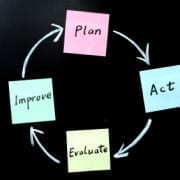4 Tips On How to Design a Presentation that Will Impress Your Audience

That being said, everyone needs to learn how to create quality presentations. In presentations, the tools used in the process and the presentation itself make the biggest impact.
Now you’re probably thinking – and what about the presenter’s speech?
Yes, this is equally important, but you can hardly make a badly designed, messy presentation look good even if you are the best speaker. This means that everything starts with the presentation.
How to Design the Perfect Presentation
When you have a ready presentation, one that perfectly and concisely captures the information, and looks amazing, your job is almost done. You can prepare your speech thanks to the ready presentation, and engage the listeners with the carefully thought-out design.
Now, how do you make a great design for your presentation? This is what this article will explore.
1. Smart use of visuals
Visual aids are used to attract the listeners’ attention and compliment your oral presentation. The goal is not to repeat the same information, but to put an emphasis on the most important things and help the presenter with their speech.
The slides in a good presentation offer a summary or a visual element that supports the data that the presenter discusses. How you arrange them and which visuals you use can have a huge impact on the audience’s engagement, as well as the presenter’s success.
Let’s see some tips for the visual elements in your presentation.
Pitch’s writer has pointed out one highly important thing when designing a presentation – visual consistency. As their guide says: “slides don’t exist in a silo”. To create a presentation, you need slides that work as a unit, which requires the perfect layout, content, design, and structure. This is why your priority should be to build consistency into the presentation from the start, to avoid endless revisions afterward.
Some excellent tricks to make this possible, according to Pitch, are slide frames and backgrounds. Even if you provide different information in different slides, you can make it consistent thanks to patterns, shapes, and similar or same backgrounds across slides.
This requires a creative touch and some experience so, if you’re struggling with creating a consistent structure, you might want to use Pitch for assistance. The tool allows you to simply add your colors, fonts, and other brand elements, and create an amazing design without any troubles.
Some other tricks related to the visual elements of your presentation are:
- Keep it simple. Over-cluttering your slides can only distract the audience, as well as the presenter. They simply ruin the design.
- Remember that one picture can tell a thousand words. Instead of writing endless content, find the perfect visual that will present that same idea.
- Think about accessibility. Using visuals is not just about using quality images, colors and fonts. It’s also about putting them on the slide. Can everyone see the visuals? Are they clear? Do they hide the content or vice versa?
2. Flowing structure
The visuals you use, as well as your speech, should be guided by the structure and content of the presentation. In most cases, presenters know what they want to say before they sit down to create it. However, many jump right at it without considering the structure, flow, and order of information.
This is where the mess happens.
Since presentation-making includes content creation as well as design, it’s important to plan it ahead. It’s similar to any other piece you create, just like the academic content you wrote at school. It is ideal to have an outline first.
How well you structure your content will have a huge effect on how good the presentation looks. This will also determine a lot of your design i.e. where you place the visuals, how you create font hierarchy, etc.
One general rule-of-thumb for structuring presentations is:
- Start with a compelling introduction. Amazing presentations always start with attention-grabbing introductions. Unless you get their attention from the start, your chances of getting them interested in your speech are much lower. This is why this is the trickiest and most important part. It needs to introduce the topic interestingly, provide some facts, and engage the audience.
- Offer a body of evidence. Once the audience knows what you’ll talk about and are eager to keep listening, it’s time to throw all the key information at them. Use evidence, facts, quotes, and everything else necessary to back up your main points. If there’s too much content in this part, reduce it to the most important parts, and use visuals to make it more appealing.
- Sum things up. Now it’s time to end your presentation, so sum it up with key takeaways, and don’t forget to ask your audience if they have questions.

In presentation-making and designing, less is more. You can’t just take the guide, book, or content you need to present and copy it into hundreds of slides. Okay, you can do it – but you definitely shouldn’t.
You also shouldn’t fill the entire slide with tons of content. Many do this and when the presentation begins, they read it word for word. That’s not how presentations should work.
The actual, tangible presentation on the screen should serve as a guide for the presenter. It’s you who has to share the information vocally, not write it all on the screen.
Even if your first content draft includes tons of data, that’s why edits are there for. You can write down everything you want to share at first, and reduce it gradually as you are designing your presentation. Ideally, you should limit the amount of copy on every slide you create to the very minimum.
Slides in your presentation should include only the key data. You should use it to point out the most important things and make them longer-lasting in the eyes of the audience. You should use it to list numbers that your audience might want to write down, or to emphasize things with percentages, quotes, and data.
When you’re creating the presentation, think ‘bite-size’. Present the information in chunks and, wherever possible, use visuals to complement the text. Inc.com reports that content that includes images produces up to 650% higher engagement compared to text-only content.
Just imagine – you are in the audience and someone talks for an hour by showing slides full of text all the time. Compare this to an experience where you can see charts, tables, images, and even videos. Which one sounds better?
It’s the latter, of course.
In terms of words in a slide, there are many opinions of the ideal number. For example, Pharmacoepi’s research shows that you need to use up to 30 words per slide. The popular 1-6-6 rule (or variants such as the 1-5-5 or 1-7-7) say that your slide should have 1 main idea, 6 bullet points, and 6 words per bullet point.
These aren’t rules and shouldn’t be taken as such. In fact, no one can tell you what the ideal word count is per slide, and it’s not obligatory to use the same system throughout your design.
In the end, it all comes down to your content, design choices, and preference. But, you should still keep your content more limited.
4. Right choice of fonts
Fonts are a tricky business when you need to present limited content, emphasize the key information, and make it visible from all angles. There are plenty of things to consider. If used properly, the font can make your design amazing. Here are some tricks that could help:
- Find the right contrast between the background and your font. If your font and background don’t fit, it won’t really matter what you put on the screen. It can be hard to read, look bad, or annoy your audience. You don’t want any of this. This is why you need to find just the right combo, the perfect contrast between your font’s color and the background.
- Use the standard fonts. It can be tempting to use those silly, bolded, or unusual fonts when you make your presentation. You may even think: “this will make it more unique and memorable”. But in most cases, this results in illegible presentation or messy content. This is why it’s safest to stick with the standards, fonts common for all computers (such as Arial, Verdana, or Tahoma). If you don’t, one big issue can occur – the computer you’re using might not have the font installed, and it will substitute it with something that doesn’t fit instead.
Wrapping up
Presentations can have a huge effect on the audience, as well as the presenter’s success. They can help you present your findings, make arguments, convince people to take action, guide them, motivate them, etc. But, to achieve all this, they need to be amazing. One huge part of it is the design. This is where you should get started – and focus on. Good luck.













Leave a Reply
Want to join the discussion?Feel free to contribute!